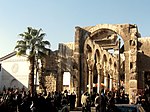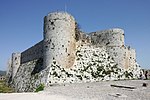This article lists the sites registered with World Heritage in Syria.
Understand
the , the Syria accepted the convention for the protection of the world cultural and natural heritage. The Syria is referred to as the Syrian Arab Republic by UNESCO. The first of the seven major Syrian protected sites was inscribed and classified in 1979 and the last in 2011.
In recent years, the country has also submitted to the Tentative List of World Heritage, twelve other sites of high cultural value.
Since , and following the ongoing civil war, the seven classified and highly threatened Syrian sites were urgently placed on the List of World Heritage in Danger.
Listing
| Site | Type | Criterion | Description | Drawing | |||||||||||||||||||||
|---|---|---|---|---|---|---|---|---|---|---|---|---|---|---|---|---|---|---|---|---|---|---|---|---|---|
| 1 Ancient city of Aleppo | Cultural | (iii), (iv) | At the crossroads of several trade routes since the IIe millennium BC AD, Aleppo has successively suffered the domination of the Hittites, Assyrians, Arabs, Mongols, Mamluks and Ottomans. Its 13th century citadele century, its 12th century Great Mosquee century and several 17th century medersa, palaces, caravanserais and hammams give Aleppo's urban fabric a harmonious and unique character, now threatened by overpopulation. | .jpg/150px-Aleppo_skyline_2011-01-08_(02).jpg) | |||||||||||||||||||||
| 2 Ancient town of Bosra | Cultural | (i), (iii), (vi) | Once the capital of the Roman province of Arabia and an important stopover on the old caravan route to Mecca, Bosra retains, enclosed in its thick walls, a magnificent Roman theater from the 2nd century, early Christian ruins and several mosques. |  | |||||||||||||||||||||
| 3 Ancient city of Damascus | Cultural | (i), (ii), (iii), (iv), (vi) | Founded in the 3rd millennium BC. AD, it is one of the oldest towns in Middle East. In the Middle Ages, Damascus was the center of a flourishing cottage industry (sabers and lace). Among the 125 monuments from different periods of its history, the Great Mosque of the Umayyads of the VIIIe century, built on the site of an Assyrian sanctuary, is one of the most spectacular. |  | |||||||||||||||||||||
| Crac des Chevaliers and Qal'at Salah El-Din 4 Crac des Chevaliers 5 Qal'at Salah El-Din | These two castles illustrate the exchange of cultural influences and the development of military architecture in the Near East during the Crusades, XIe to XIIIe centuries. The Crac des Chevaliers was built by the Order of the Hospitallers of Saint John of Jerusalem from 1142 to 1271. A second wave of work was carried out by the Mamluks at the end of the 13th century.e century. It is one of the best preserved Crusader castles. Although partially in ruins, the Qal'at Salah El-Din (Fortress of Saladin) is another remarkable example of this type of fortress, both in terms of the quality of the construction and the survival of the historical stratigraphy, with elements of the Byzantine period in the 10th century, the transformations carried out by the Franks at the end of the 12th century and the defenses added by the Ayyoubids (end of the 12th and 13th centuries). |  | |||||||||||||||||||||||
| 6 Palmyra site | Cultural | (i), (ii), (iv) | Oasis of the Syrian desert north-east of Damascus, Palmyra is home to the monumental ruins of a large city that was one of the most important cultural centers of the ancient world. At the crossroads of several civilizations, the art and architecture of Palmyra united in the 1st and 2nd centuries Greco-Roman techniques with local traditions and Persian influences. |  | |||||||||||||||||||||
| 7 Ancient villages of northern Syria | Cultural | (iii), (iv), (v) | Located in the north-west of Syria, some forty villages, grouped within eight parks, offer remarkable testimony to the rural and village lifestyles of late Antiquity and the Byzantine period. Abandoned during VIIIe ‑ Xe centuries, these villages, which date from Ier to VIIe centuries, offer a landscape and particularly well-preserved remains: residential houses, pagan temples, churches, collective cisterns, thermal baths, etc. These relict cultural landscapes are an important illustration of the transition between the ancient pagan world of the Roman Empire and Byzantine Christianity. The remains testifying to hydraulic techniques, protective walls and Roman plots show us to what extent the inhabitants mastered agricultural production. |  | |||||||||||||||||||||
Criteria legend
| |||||||||||||||||||||||||
